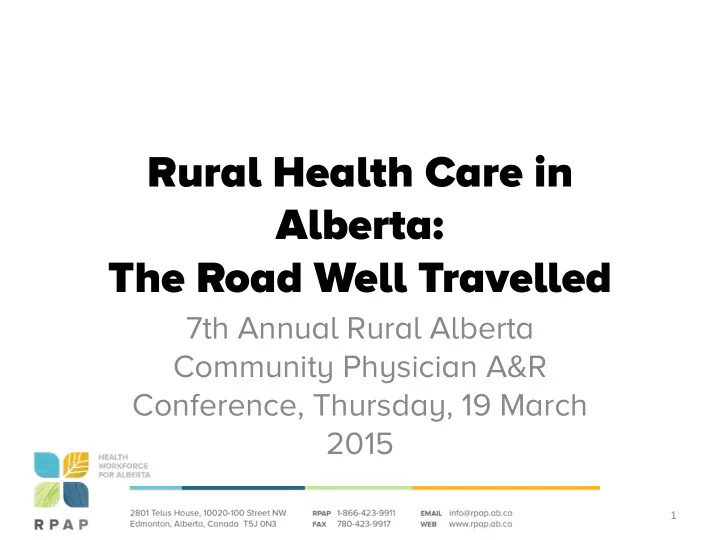

Rural Health Care in Alberta: The Road Well Travelled 7th Annual Rural Alberta Community Physician A&R Conference, Thursday, 19 March 2015 1
Outline • What’s RPAP? • … And last time we talked about … • Current landscape of health care in rural Alberta • Now what do we do? 2
WHAT’S RPAP? 3
What’s RPAP • RPAP developed on the basis of influencing physicians' decisions about moving to and remaining in a rural Alberta community • RPAP was originally comprised of 16 initiatives, focused on three distinct target groups • RPAP programming is continually refined based on external evaluations, international best practices, internal studies and key performance measures. • RPAP embraces partnerships and collaboration within Alberta and beyond 4
RPAP Attraction, Recruitment & Retention Strategies • Mid-long term – integrated “Education Pipeline” strategy • Mid-Long term – building “community” A&R capacity • Short-mid term – APLJobs.ca provincial recruitment website & related activities • Partnerships & Collaboration 5
6
… AND THE LAST TIME WE TALKED .. 7
… and last time we talked about… 8
… and last time we talked about… 9
… and last time we talked about… 10
… and last time we talked about… 11
… and last time we talked about… 12
… and last time we talked about… 13
… and last time we talked about… 14
CURRENT LANDSCAPE OF HEALTH CARE IN RURAL ALBERTA 15
Current landscape – What we know Practitioners are not distributed to the areas of need nor practice to • their full scope Even with medical school/residency expansion, International • Medical Graduates (IMGs) (and the growing CMSA component) will continue to represent a sizeable part of the physician workforce into the future Work life balance issues affect Recruitment & Retention (R&R) • The community can play a key role in Attraction & Retention (A&R) • Canadian and international experience demonstrates that patient • attachment and the involvement of primary health care teams can lower costs and minimize physician visits versus episodic treatment which has higher cost and poorer outcomes 16
17
Current landscape 18
Current landscape 19
Current landscape 20
Current landscape 21
Current landscape 22
Practitioner Attraction, Recruitment & Retention • A lot is being done. • We need to celebrate our successes. • There are no quick fixes. • We are following « best practices » 23
24
25
26
27
NOW WHAT DO WE DO? 28
Now what do we do? • From RPAP’s extensive work in rural Alberta, this is what we hear rural Alberta communities say: Rural Alberta - – Needs access to the right healthcare provider at the right time and this is not always a physician – Needs better distribution of the health care work force to areas of need – Recognizes better outcomes result when healthcare providers are linked into communities of practice, i.e. are “plugged into” the health care system and not permitted to be “free standing” 29
Now what do we do? Parts of Rural Alberta & Rural Canada are still struggling to sustain • health care as it was developed since WWII We need to change how we deliver health care in Alberta towards a • system in which Albertan’s have access to reliable, sustainable and predictable health care services. (Rural) Alberta requires a health services plan that: • – specifies the specific health care services that are to be provided (community primary care, continuing care, emergency and acute care) – where those services are to be provided; and, – the resources to be provided over multiple years to nurture them. Only then can we organize the supports to the health care system – • people, buildings, training organizations, funders, etc. – to achieve success. 30
Now what do we do? • For community primary care, success might look like this: – Develop and sustain “hub and spoke” models of care (where the critical mass of physicians and other health care workers exist and are supported), – Change how physicians are paid (move to blended models that promote comprehensive care w/ accountability measures), and – Change how physicians are organized (accountable community primary care models with other health care workers and a functioning electronic health record). 31
Thank-you! 7th Annual Rural Alberta Community Physician A&R Conference Thursday, 19 March 2015 32
Recommend
More recommend